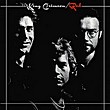|
|

From head to heart Following our retroscope series of latter years, here we go again! Here's Speakers' corner's cousin; From head to heart. Luna Kafé's focused eye on great events, fantastic happenings, absolute milestones, or other curious incidents from the historic shelves'n'vaults of pop'n'rock. Blowing our ears and our head, punching our chest and shaking our heart. Making us go sentimental, but not slaphappy. This moonth the Lunar shuttle touch down 40 years back in time, to revisit the crimson kings of the progressive (late 60s and) 70s (and 80s, and 90s, and on) 'Crimson is a strong, deep red color. It originally meant the color of the Kermes dye produced from a scale insect, Kermes vermilio, but the name is now sometimes also used as a generic term for slightly reddish-blue colors that are between red and rose.' (Wikipedia). Add even more red and the red turns as deep, dark red as deep, dark red can be.
On the back side of the album is a photo of an old fashioned gauge, or VU meter if you wish, the kind that indicated the volume of the sound on a mixing board and other sound recording devices. It's going well into the red, which signals distorted sound. So I guess Red indicates distorted contents. And it is. Well, not to the extent of for instance Velvet Underground's White Light/White Heat, a bit more controlled, but distorted all the same. Red was the studio swan song of the remains of the third incarnation of King Crimson that was formed less than two years prior as a quintet, the one that recorded Larks' Tongues In Aspic. Red was recorded after a long North American tour from the end of April to 1. July 1974. At that time the band counted Robert Fripp (guitars and Mellotron), John Wetton (bass and vocals), Bill Bruford (drums and percussion) and David Cross (violin and Mellotron). The latter left the band by the end of the tour. The remaining three started the recording of album the following week with some help from previous members and friends. And Robert Fripp announced the band had folded by the end of September, two weeks before Red was released. By first glance it seems like a bit cheap album. Dark cover in black and white except the album title, in red. It clocks in at 40 minutes which was a bit on the short side back then. Only five tracks. The opening title track is instrumental and returns in disguise as "One More Red Nightmare" with lyrics as the third track. The fourth, called "Providence" is an instrumental improvised one, recorded live at Palace Theatre in (surprise-surprise!) Providence, Rhode Island, USA on 30 June, the band's second to last live performance. Only two more songs and that's it. But, of course, quantity and quality are different matters. The title track is an electric guitar monster, as goes for the majority of the album, thinking of it. Hardly an acoustic guitar in sight. "Red" the instrumental is dominated by a very much and a little less distorted guitar that are all over the place. Mainly it only consists of a couple of cool riffs by Mr. Fripp, the main one repeated at changing keys. And with a calmer, but eerier passage two thirds in. A crafty guitar exercise, indeed. With Wetton's rumbling bass and Bruford's highly strung drum skins underneath. It's a favourite, especially being the only track by King Crimson of the 1969-1974 era that I've witnessed live fronted by Robert Fripp. It sounded as cool in 2003 as when the album was released 29 years earlier, or today. "One More Red Nightmare" doesn't start too promising, with a main riff that reminds of the main one from "Red" as its backbone. The riff is still cool and heavy, but Wetton's condensed voice is not quite up to par. By the first short chorus it has improved. Long heavy instrumental guitar and sax passages with a distorted bass and a strange echo effect on the drums build it even higher. "Fallen Angel" is another King Crimson classic, mid tempo, but with unusual straight time signatures, 4/4 and 3/4. Close to ballad ilk initially, the guitar sounds almost lyrical at the start compared to the heaviness of other Red tracks. The same goes for the sax played by Ian MacDonald from the first King Crimson incarnation in 1969 and the cornet of jazzman Mark Charig who guested on a couple of previous recordings by the second incarnation of the band. The song is about a boy who joins Hell's Angels, and grows heavier towards his brutal death. A great song that originally had started as a live improvisation almost two years earlier. I'm not the most eager fan of the free-form improvisational King Crimson. "Providence" starts pretty free, with squeaks from the violin of David Cross, then sounds quite pretty until the others join in with growls and noises. At some points it sounds like a modern serious piece of written music until Wetton's distorted bass deliberately ruins the mood. Eventually Bill Bruford starts to play more rhythmically and the beast grows into something more cohesive. Anyway it's a relief when it is substituted with the harmonic Mellotron that signals the start of the last piece of the album, the 12 minutes long "Starless". "Starless" was originally written by John Wetton as the title track for Crimson's previous album Starless And Bible Black earlier in 1974. The other boys in the band didn't like it and it was substituted with an improvisational instrumental. But Wetton's song was augmented and lyrics were changed with help from his friend Richard Palmer-James, who also wrote most of the lyrics for the two previous albums. The first part of the song is a conventional Crimson Mellotron-laden ballad, much in the tradition of "Epitaph" from the debut album In The Court Of The Crimson King back in October 1969, "Book Of Saturday" from Larks' Tongues one and a half year prior and others. Fripp's almost glass clear, for a change, guitar takes care of the initial sad melody line that David Cross played on violin on the previous tour. John Wetton sings straight forward and effortlessly, at times almost like an English school choir boy, quite similar to Greg Lake's voice of "Epitaph" five years earlier. The sax interweaves with the vocals and a bit of cello, too. Very beautiful, very melancholic, but hardly innovative. But four and a half minutes into the song, after the return of the glass guitar and the last verse, something starts to happen... The mood is changed with the arrival of some eerie Fripp guitar licks, repeating the same note over and over again until it changes to another after a few bars. Enter the distorted bass of Wetton that really drives this instrumental part forward over Bruford's steady beats spiced with a lot of percussives if you listen carefully. It grows heavier and heavier by the minute while my neck, back and leg hairs rises on end until the climax where Fripp almost enters the role of a guitar hero of the Jimi Hendrix kind and the music explodes into a jazzy sax solo that somehow brings us back to reality and conventional terrain. Then another round of guitar mayhem and climax that to some extent reminds of "21st Century Schizoid Man", the fist blow of an opening track from the debut album. Electric rock'n'roll can hardly sounds cooler! The song is eventually rounded off with more Mellotron and the initial guitar theme repeated on sax and also oboe this time, I think. Inspired by some movement by French composer Olivier Messiaen, the saying goes. What a swan song! I read an interview with renowned Norwegian author Kjartan Fløgstad this summer when he turned 70 years old. He was of course asked the obligatory questions about favourite dish, book, film, holiday destination, ... His answer for the question about favourite music was "Starless" by John Wetton and (my underlining) King Crimson. I don't know how deliberate this was, but I can wholeheartedly agree that Wetton's vocal and bass efforts on "Starless" alone ought to give him a place of honour in rock history. Though I fear his career move after Crimson had folded, to join Uriah Heep (for one album), might have harmed his reputation seriously... Anyway, to conclude, if there is one song that really sums up what King Crimson of the 1969-74 era was about, "Starless" is it. And I might add that Red wasn't only the end of the studio King Crimson back then, I guess it might serve as the end of the first wave of progressive rock, too, in the true sense of the word progressive. Last year saw the release of a 24 disc CD/DVD/Blue-ray monster box called The Road To Red with all available live recordings by the band from the tour prior to the album recordings, a new mix of the live album USA from the same tour, that was originally released in May 1975, ditto and surround versions of the studio album etc. A new seven piece line-up of the band including Fripp, Mel Collins and more recent members from the 1980s and onwards has just finished another tour of North America. A new monster box, this time dealing with the album Starless And Bible Black, will be released later this moonth. The King Crimson legacy lives on! Copyright © 2014 JP
|
| You may also want to check out our King Crimson articles/reviews: ConstruKction of Light, In The Court Of The Crimson King, Larks' Tongues In Aspic, Power To Believe Tour Book, Radical Action To Unseat The Hold Of Monkey Mind. |
| © 2014 Luna Kafé |
 King Crimson
King Crimson